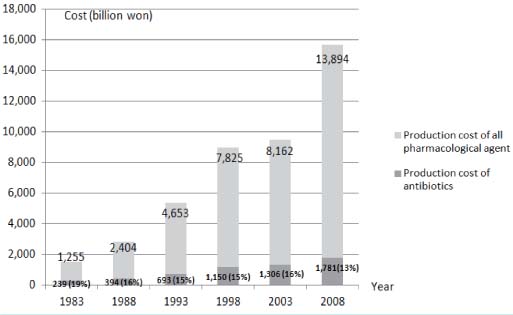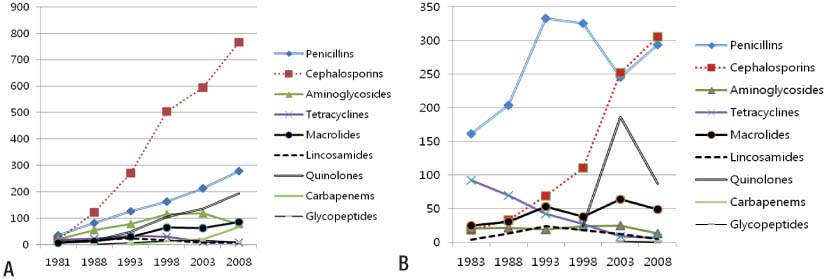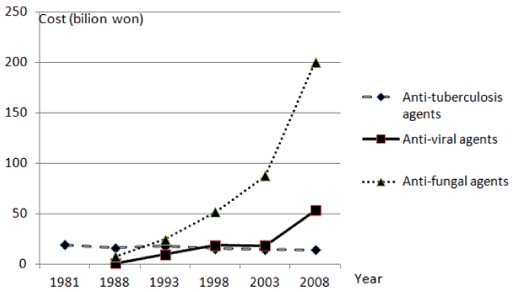Infect Chemother.
2012 Dec;44(6):411-418. 10.3947/ic.2012.44.6.411.
The Changing Patterns of Antibiotics Usage in Korea during 1981-2008
- Affiliations
-
- 1Department of Internal Medicine, The Catholic University of Korea, Seoul, Korea. infect@catholic.ac.kr
- KMID: 1806921
- DOI: http://doi.org/10.3947/ic.2012.44.6.411
Abstract
- BACKGROUND
The actual trends in antibiotic use in Korea are difficult to determine because antibiotic usage, which is not covered by insurance or not consumed in all hospitals in Korea, cannot be calculated accurately. Therefore, this study estimated the antibiotic usage indirectly from the data available in the 'Annual Products of Medicine,' which is published by the Korean Pharmaceutical Manufacturers Association.
MATERIALS AND METHODS
The data from 'Annual Products of Medicine in 2008' was analyzed. The cost and amounts of antibiotics produced were calculated and compared with previous data.
RESULTS
In 2008, the total cost of antibiotics was $ 1.6 billion, and the total amount was 1,140 tons. Since 1993, there has been an upward trend in the total amount of antibiotics produced. In contrast, there has been a downward trend in the proportion of antibiotics among all pharmacological agents produced. In terms of the amount, the production of cephalosporins was highest since 2003, whereas the production of penicillins was highest before 2003. The production of third and fourth generation cephalosporins is increasing, whereas that of first generation cephalosporins is decreasing gradually. Regarding the class of penicillins, the production of beta-lactam/beta-lactamase inhibitor combinations was the highest after 2003, whereas the production of aminopenicillin was the highest before 2003. Compared to 2003, although the amount of quinolones produced in 2008 has decreased by 52.9%, the cost increased by 41.7%. This was attributed to an increase in the production of ciprofloxacin and levofloxacin instead of older quinolones. Since 1993, aminoglycoside, tetracycline, lincosamide and chloramphenicol have been decreasing in both amount and cost. The increase in carbapenems (241.9%), antifungals (128.4%) and antiviral agents (193.2%) in 2008 is remarkable compared to that in 2003.
CONCLUSIONS
The production and cost of broader spectrum and more expensive antibiotics are increasing, and is believed to be responsible for the emergence of resistance. Therefore, restriction of these broader spectrum antibiotics, such as carbapenems, is recommended.
Keyword
MeSH Terms
Figure
Cited by 1 articles
-
Management of Typhoid Fever – Clinical and Historical Perspectives in Korea
Mee Soo Chang, Jun Hee Woo, Sungmin Kim
Infect Chemother. 2019;51(3):330-335. doi: 10.3947/ic.2019.51.3.330.
Reference
-
1. The Korean Society of Infectious Diseases. The guide of antibiotics use. 2008. 3rd ed. Seoul: MIP.2. Song JH. Antimicrobial resistance in gram-positive cocci: past 50 years, present and future. Infect Chemother. 2011. 43:443–449.
Article3. Lee K. Trend of bacterial resistance for the past 50 years in Korea and future perspectives – gram-negative bacteria. Infect Chemother. 2011. 43:458–467.
Article4. Göttig S, Pfeifer Y, Wichelhaus TA, Zacharowski K, Bingold T, Averhoff B, Brandt C, Kempf VA. Global spread of New Delhi metallo-β-lactamase 1. Lancet Infect Dis. 2010. 10:828–829.
Article5. Poirel L, Hombrouck-Alet C, Freneaux C, Bernabeu S, Nordmann P. Global spread of New Delhi metallo-β-lactamase 1. Lancet Infect Dis. 2010. 10:832.
Article6. Korea Pharmaceutical Manufacturers Association. Annual products of medicine. 2008. Seoul: KPMA.7. Kang MW, Chung HY. Trends of antimicrobial drug usage in Korea. Korean J Infect Dis. 1982. 14:31–35.8. Kang MW, Chung HY. Trends of antibiotic usage in Korea. Korean J Infect Dis. 1989. 21:257–263.9. Kim YJ, Yoon CH, Baek KH, KIM YR, Yoo JH, Shin WS, Kang MW. The trend of antibiotics usage in Korea (II). Korean J Infect Dis. 1995. 13:43–55.10. Kim SI, Park JM, Wie SH, Kim YR, Kang MW. The trend of antibiotics usage in Korea during 1981-1998. Korean J Infect Dis. 2000. 32:439–447.11. KIM YJ, Lee SH, Kang YN, KIM WC, KIM SI, Wie SH, Kim YR, Kang MW. The trend of antibiotic production in Korea during 1981-2003. Infect Chemother. 2005. 37:271–279.12. WHO. WHO collaborating Center for Drug Statistics Methodology. Accessed 1 November 2011. Available at: http://www.whocc.no/atc_ddd_index/.13. Lee K, Lee MA, Lee CH, Lee J, Roh KH, Kim S, Kim JJ, Koh E, Yong D, Chong Y. KONSAR Group. Increase of ceftazidime- and fluoroquinolone-resistant Klebsiella pneumoniae and imipenem-resistant Acinetobacter spp. in Korea: analysis of KONSAR study data from 2005 and 2007. Yonsei Med J. 2010. 51:901–911.
Article14. KIMS. KIMSonline. Accessed 1 July 2011. Available at: http://www.kimsonline.co.kr/001_Detail/DrugDetailSearch.aspx?idx=aa.15. Lee S, Lee K, Kang Y, Bae S. Prevalence of serotype and multidrugresistance of Streptococcus pneumoniae respiratory tract isolates in 265 adults and 36 children in Korea, 2002-2005. Microb Drug Resist. 2010. 16:135–142.
Article16. Kim SI, Kang MW. Current usage and prospect of new anti-fungal agents in Korea. Infect Chemother. 2010. 42:209–215.
Article17. Lee EK, Jang SM. Analysis of antibiotic consumption using the DDD(the defined daily dose) methodology and antibiotic expenditure. J Korean Soc Clin Pharmacol Ther. 2000. 8:28–43.
Article
- Full Text Links
- Actions
-
Cited
- CITED
-
- Close
- Share
- Similar articles
-
- Evaluation of Changed Antibiotics in Case of Positive Antibiotics Skin Test
- Clinical Obseervation and Changing Patterns of Resistance to Antibiotics in Childhood Shigellosis
- The Trend of Antibiotics Usage in Korea during 1981-1998
- Myths and Misconceptions around Antibiotic Resistance: Time to Get Rid of Them
- Patterns of antibiotics and pathogens for anastomotic leakage after colorectal cancer surgery




